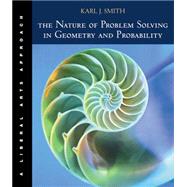
Note: Supplemental materials are not guaranteed with Rental or Used book purchases.
Purchase Benefits
What is included with this book?
| Prologue-Why Math? A Historical Overview | P1 | ||||
| 1 THE NATURE OF PROBLEM SOLVING | |||||
|
2 | (14) | |||
|
16 | (8) | |||
|
24 | (15) | |||
|
39 | (8) | |||
|
47 | (6) | |||
| 2 THE NATURE OF LOGIC | 53 | (48) | |||
|
54 | (7) | |||
|
61 | (8) | |||
|
69 | (6) | |||
|
75 | (9) | |||
|
84 | (6) | |||
|
90 | (4) | |||
|
94 | (7) | |||
| 3 THE NATURE OF SET THEORY AND COUNTING | 101 | (54) | |||
|
102 | (7) | |||
|
109 | (8) | |||
|
117 | (8) | |||
|
125 | (5) | |||
|
130 | (10) | |||
|
140 | (5) | |||
|
145 | (3) | |||
|
148 | (7) | |||
| 4 THE NATURE OF PROBABILITY | 155 | (56) | |||
|
156 | (11) | |||
|
167 | (9) | |||
|
176 | (11) | |||
|
187 | (8) | |||
|
195 | (206) | |||
|
198 | (7) | |||
|
205 | (6) | |||
| 5 THE NATURE OF STATISTICS | 211 | (58) | |||
|
212 | (14) | |||
|
226 | (11) | |||
|
237 | (10) | |||
|
247 | (8) | |||
|
255 | (7) | |||
|
262 | (7) | |||
| 6 THE NATURE OF GEOMETRY | 269 | (56) | |||
|
270 | (9) | |||
|
279 | (8) | |||
|
287 | (6) | |||
|
293 | (7) | |||
|
300 | (8) | |||
|
308 | (6) | |||
|
314 | (6) | |||
|
320 | (5) | |||
| 7 THE NATURE OF MEASUREMENT | 325 | (46) | |||
|
326 | (8) | |||
|
334 | (10) | |||
|
344 | (11) | |||
|
355 | (11) | |||
|
366 | (5) | |||
| 8 THE NATURE OF GROWTH | 371 | (30) | |||
|
372 | (8) | |||
|
380 | (7) | |||
|
387 | (10) | |||
|
397 | (4) | |||
| 9 THE NATURE OF NETWORKS AND GRAPH THEORY | 401 | ||||
|
402 | (12) | |||
|
414 | (11) | |||
|
425 | (5) | |||
|
430 | (5) | |||
|
435 | ||||
|
436 | ||||
| Epilogue-Why Not Math? Mathematics in the Natural Sciences, Social Sciences, and Humanities | E1 | ||||
| APPENDICES | |||||
|
G1 | ||||
|
A1 | ||||
|
C1 | ||||
|
I1 |
The New copy of this book will include any supplemental materials advertised. Please check the title of the book to determine if it should include any access cards, study guides, lab manuals, CDs, etc.
The Used, Rental and eBook copies of this book are not guaranteed to include any supplemental materials. Typically, only the book itself is included. This is true even if the title states it includes any access cards, study guides, lab manuals, CDs, etc.